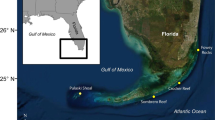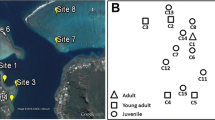Abstract
An electrophoretic study of genetic differentiation amongst local populations of the reef-coral Pocillopora damicornis was used to group coral heads into units defined as the area of effective dispersal of a clone, and termed “colonies”. For reefs off southwestern Australia, colonies were usually under a few hundred metres in extent. Although most new recruits within a colony were derived asexually, sexually produced propagules acted to connect populations outside the boundaries of a colony. Such connections were weak, and allelic frequencies varied considerably over a few kilometres. The primary agent of genetic differentiation was suggested to be the small effective population size resulting from the asexual proliferation of a few genotypes at any site. The effective number of genotypes per colony was approximately six. Asexual reproduction appears also to limit gene flow and accentuate selection in this species.
Similar content being viewed by others
References
Bell G (1982) The masterpiece of nature: the evolution and genetics of sexuality. Croom Helm, London
Connell JH (1973) Population ecology of reef-building corals. In: Jones OA, Endean R (ed) Biology and geology of coral reefs, vol 2: Biology I. Academic Press, New York London, pp 205–245
Crisp DH (1976) The role of the pelagic larva. In: Spencer-Davis P (ed) Zoology. Pergamon Press, London, pp 145–155 (Perspectives in environmental biology, vol 1)
Crow JF, Kimura M (1970) An introduction to population genetics theory. Harper & Row, New York
Curie-Cohen M (1982) Estimates of inbreeding in a natural population: a comparison of sampling properties. Genetics 100:339–358
Dana TF (1975) Development of contemporary eastern Pacific reef corals. Mar Biol 33:355–374
Davis BJ, DeMartini EE, McGee K (1981) Gene flow among populations of a teleost (Painted greenling, Oxylebius pictus) from Puget Sound to southern California. Mar Biol 65:17–23
Doyle RW (1975) Settlement of planktonic larvae; a theory of habitat selection in varying environments. Am Nat 109:113–125
Eanes WF, Koehn RK (1978) An analysis of genetic structure in the Monarch Butterfly, Danaus plexippus L. Evolution 32:784–797
Gartner-Kepkay KE, Zouros E, Dickie LM, Freeman KR (1983) Genetic differentiation in the face of gene flow: a study of mussel populations from a single Nova Scotian embayment. Can J Fish Aquat Sci 40:443–451
Gilbert N (1973) Biometrical interpretation. Clarendon Press, Oxford
Glesener R, Tilman D (1978) Sexuality and the components of environmental uncertainty: clues from geographical parthenogenesis. Am Nat 112:659–673
Grant WS, Milner GB, Krasnowski P, Utter FM (1980) Use of biochemical genetic variants for identification of Sockeye salmon (Oncorhynchus nerka) stocks in Cook Inlet, Alaska. Can J Fish Aquat Sci 37:1236–1247
Harriot V (1983) Reproductive seasonality, settlement, and postsettlement mortality of Pocillopora damicornis (Linnaeus), at Lizard Island. Coral Reefs 2:151–158
Hedgecock D, Schleser RA, Nelson K (1976) Application of biochemical genetics to aquaculture. J Fish Res Board Can 53:1108–1119
Highsmith RC (1982) Reproduction by fragmentation in corals. Mar Ecol Prog Ser 7:207–228
Johnson MS (1971) Adaptive lactate dehydrogenase variation in the crested blenny, Anoplarchus. Heredity 27:205–226
Johnson MS, Black R (1984) The Wahlund effect and the scale of geographical variation in an intertidal limpet, Siphonaria sp. Mar Biol 79:295–302
Kimura M, Weiss WH (1964) The stepping-stone model of genetic structure and the decrease of genetic correlation with distance. Genetics 49:561–576
Koehn RK, Turano FJ, Mitton JB (1973) Population genetics of marine pelecypods. II. Genetic differentiation in microhabitals of Modiolus demissus. Evolution 27:100–105
Levinton JS, Suchanek TH (1978) Geographic variation, niche breadth and genetic differentiation at different geographic scales in the mussels Mytilus californianus and Medulis. Mar Biol 49:363–375
Li CC (1969) Population subdivision with respect to multiple alleles. Ann Hum Genet 33:23–29
Maynard Smith J (1978) The evolution of sex. Cambridge University Press, Cambridge
Nei M (1978) Estimation of average heterozygosity and genetic distance from a small number of individuals. Genetics 89:583–590
Pearson RG (1981) Recovery and recolonisation of coral reefs. Mar Ecol Prog Ser 4:105–122
Phillips BF (1981) The circulation of the southeastern Indian Ocean and the planktonic life cycle of the Western Rock Lobster. Oceanogr Mar Biol, Ann Rev 19:11–39
Richardson BJ (1982) Geographical distribution of electrophoretically detected protein variation in Australian commercial fishes. II. Western King Prawn, Penaeus latisulcatus Kishinouye. Aust J Mar Freshwater Res 33:933–937
Richmond RH (1981) Energetic considerations in the dispersal of Pocillopora damicornis (Linnaeus) planulae. Proc 4th int Coral Reef Symp 2:153–156
Rochford DJ (1969) Scasonal variations in the Indian Ocean along 110°E. I. Hydrological structure of the upper 500 metres. Aust J Mar Freshwater Res 20:1–50
Rosen BR (1979) Introduction, modules, members and communities. In: Larwood G, Rosen BR (eds) Biology and systematics of colonial organisms. Academic Press, London New York, pp XIII-XXXV
Scheltema RS (1978) On the relationship between dispersal of pelagic veliger larvae and the evolution of marine prosobranch gastropods. In: Battaglia B, Beardmore JA (eds) Marine organisms: genetics, ecology and evolution. Plenum Press, New York, pp 303–322
Siegels S (1956) Non-parametric statistics for the behavioural sciences. McGraw-Hill, New York
Sneath PHA, Sokal RR (1973) Numerical taxonomy. Freeman, San Francisco
Snedecor G, Irwin MR (1938) On the chi-square test for homogeneity. Iowa State J Sci 8:75–81
Stoddart JA (1983) Asexual production of planulae in the coral Pocillopora damicornis; Mar Biol 76:279–284
Stoddart JA (1984a) Genetic structure within populations of the coral Pocillopora damicornis. Mar Biol 75:81:19–30
Stoddart JA (1984b) The genetical structure of populations of the coral Pocillopora damicornis. PhD thesis, University of Western Australia
Stoddart JA (1984) Biochemical genetics of Pocillopora damicornis in Kaneohe Bay, Oahu, Hawaii. In: Jokiel PL, Richmond RH (eds) Population biology of coral reefs. Hawaii Inst Mar Biol, Tech Rep No 37
Williams GC (1975) Sex and evolution Princeton University Press, Princeton
Williams GC, Koehn RK, Milton JB (1973) Genetic differentiation without isolation in the American eel, Anguilla rostrata. Evolution 27:192–204
Winans GA (1980) Geographic variation in the milkfish Chanos chanos. I. Biochemical evidence. Evolution 34:558–574
Wright S (1943) Isolation by distance. Genetics 28:114–138
Wright S (1951) The genetic structure of populations. Ann Eugen 15:323–354
Wright S (1978) Evolution of the genetics of populations, vol IV: Variability in natural populations. University of Chicago Press, Chicago
Author information
Authors and Affiliations
Rights and permissions
About this article
Cite this article
Stoddart, J.A. Genetic differentiation amongst populations of the coral Pocillopora damicornis off southwestern Australia. Coral Reefs 3, 149–156 (1984). https://doi.org/10.1007/BF00301959
Accepted:
Issue Date:
DOI: https://doi.org/10.1007/BF00301959




